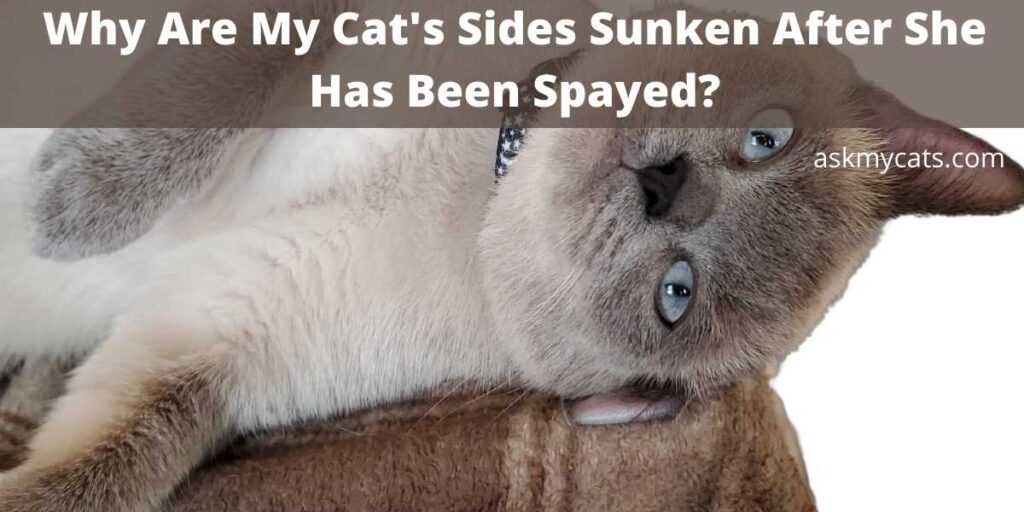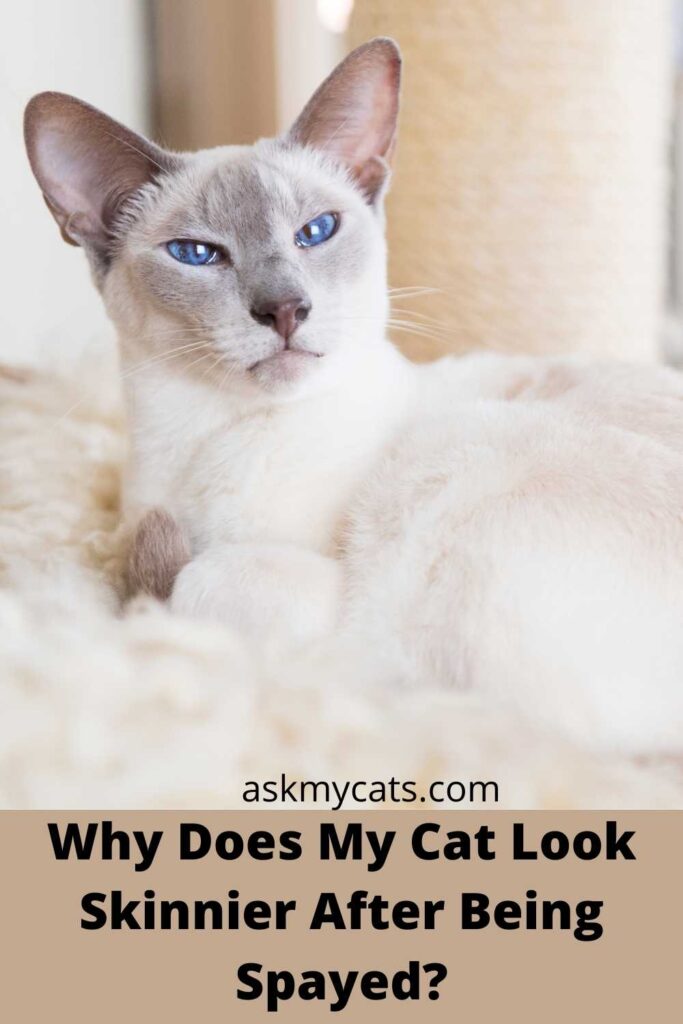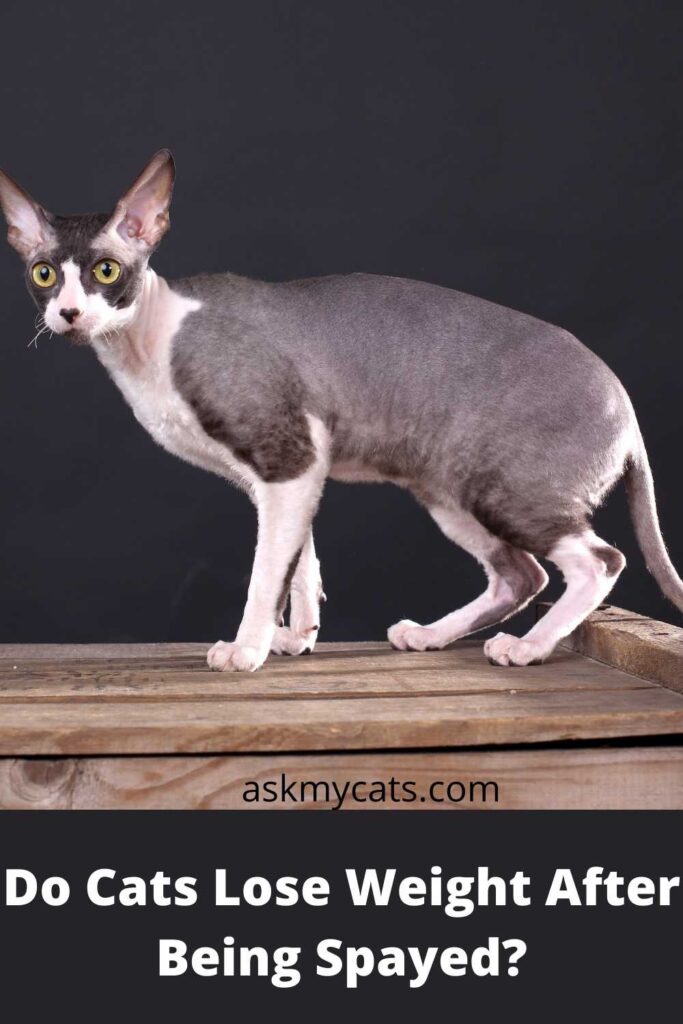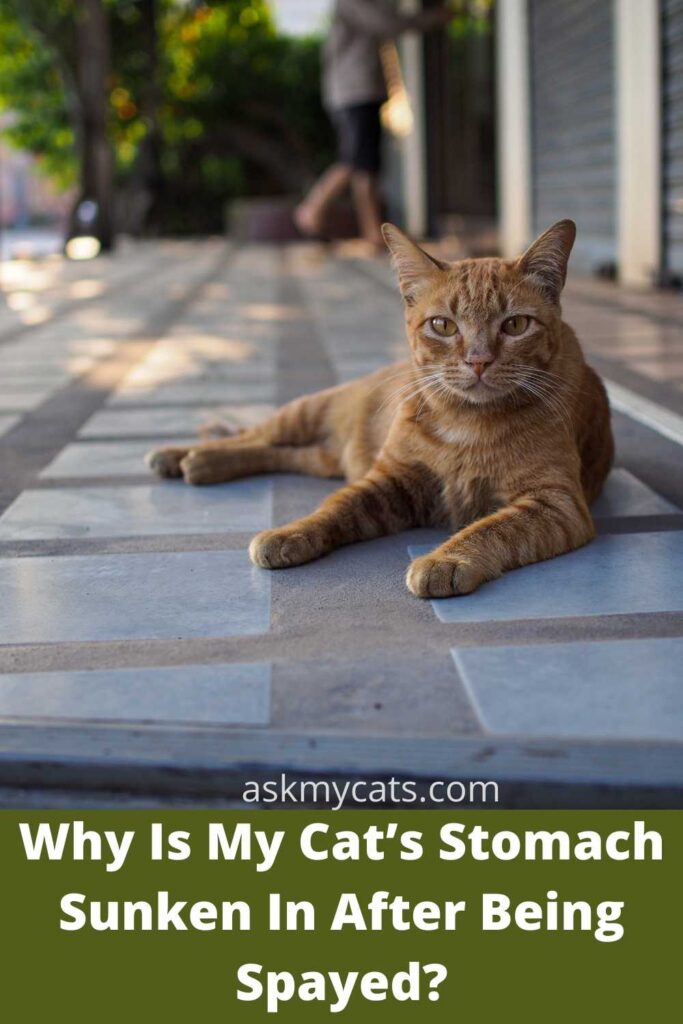So you have noticed that your cat’s sides have sunken after she has been spayed. Although it is not an uncommon sight, it might look concerning.
When I got my first cat spayed, I took this situation very seriously, and let me tell you that in this article we will talk about why this happens and how to look after her after the surgery.
Many cat owners are unaware that this behavior is very natural for a cat who has recently undergone spaying. The appearance often lasts a few days. Your cat’s body returns to its pre-surgery state following the procedure.
Check it out.


Give Your Cat the Perfect Day
Get the Free Ebook!
Why Does My Cat Look Skinnier After Being Spayed?

The cats typically appear skinny, but since they shave their undersides, this is more of an optical illusion. If you’ve ever had your cat spayed, you’ve probably noticed that her tummy has a small pouch protruding from it. This tiny pouch gives your cat’s flanks a hollowed-out appearance, making them appear smaller.
Your cat must be sedated in some way or undergo the invasive “ovariohysterectomy” procedure. The cat loses appetite as a result of being drugged and having her inside exposed.
So, it’s not unusual for a cat to start eating less a day or two after surgery.
However, your cat’s loss of appetite and any other changes will pass in a week, or in extremely unusual circumstances, two weeks.
You should call your veterinarian if any severe symptoms, such as vomiting, blood, or diarrhea, continue after that time.
The removed organs are incredibly thin, possibly the thickness of the yarn. And the stitches just serve to reattach already joined skin.
She won’t go out of shape because there isn’t enough strain. Although it is understandable that improper eating or drinking could contribute,
She might be in some pain if she had her spay done and was then immediately brought home.
Ask yourself- Do they send you home with painkillers, you wonder? Or give her something that should still be effective at the hospital?
It is advisable for cats to spend at least one night at the veterinarian’s office so they can be watched and rest for a bit. Additionally, it is more frequent to administer injectable painkillers.
Do Cats Lose Weight After Being Spayed?

NO, cats are not supposed to lose weight after being spayed. Instead, it is generally seen that felines have a little weight gain after the surgery.
Although the average cat should weigh between 7 and 12 pounds, each cat’s optimal weight will vary depending on its size and form, so we focus on the physical condition score rather than just weight.
If your cat is 10% or more over the ideal weight, he is overweight; if he is 20% or more over the ideal weight, he is obese.
It has been demonstrated that cats who have been spayed are more prone to gaining weight.
Although it is usually advised to cut back on food intake by 20 to 30% following this treatment and regularly monitor body condition, it’s still critical to feed your kitten a diet that supports growth until he is at least a year old.
Numerous illnesses, including diabetes, skin conditions, and arthritis or joint discomfort, have been linked to feline obesity. Although you might not notice any issues, obese pets are more likely to require anesthesia and have higher medical bills.
Studies have shown that having excess body fat makes the body more prone to inflammation, and we are only now learning about the myriad health issues that chronic inflammation may cause.
Commercial diets created for cats that want to lose weight are heavy in protein to make up for the cat’s low-calorie intake.
Your veterinarian will examine it and perhaps run health exams, including blood tests, to establish the amount of protein and other nutrients that are best for your cat.
Interesting Read: Why Is My Cat Always Hungry After Being Spayed?
Is It Normal For Cats To Lose Weight After Being Spayed?
Your cat may appear to be thin, but she shouldn’t lose any weight. A more common phenomenon is when she gains weight post-operation.
Having been spayed, cats do tend to put on some weight. A cat’s metabolism will slow down a little after spaying, and some body fat may be moved to other areas of the body, particularly the abdomen, leading to the infamous abdominal fat pad.
It’s crucial to cut back on the food you feed your cat after spaying while continuing to encourage play and exercise.
Although the first year of a cat’s life is considered the “kitten stage,” if the cat is gaining too much weight, it may be essential to transition from high-calorie kitten food to a lower-calorie adult maintenance meal before the end of the first year.
Why Is My Cat’s Stomach Sunken In After Being Spayed?

A cat can develop sunken sides after spaying because of her missing reproductive organs.
A cat’s sides will frequently appear sunken following spaying for a variety of reasons. The following reasons make the look primarily an illusion:
- Your cat will experience a notable weight loss following surgery.
- Your cat’s reproductive organs are absent.
- Only as your cat gets skinnier will the pouch become apparent.
Due to the procedure and anesthesia, a cat who has been spayed will experience a temporary drop in appetite. Her digestive system empties due to her lack of eating. In other words, while the procedure is taking place, your cat will appear to be losing weight.
She shouldn’t, however, lose any weight over time. Only when she had her operation did she lose weight.
The body component, which is also referred to as the primordial pouch by scientists, is a layer of fat and fur that shields your cat’s stomach, which is her most vulnerable area. Its primary function is to protect a cat’s stomach from an attack.
Due to her body filling out enough to seem spherical, a fat or medium-weight cat’s pouch is not noticeable.
Just keep in mind that your cat’s weight loss in the stomach region is concealed by the primordial pouch. Her rehabilitation will go smoothly from here on, and her body will probably adapt back to its correct equilibrium as long as she is well-fed and well-rested.
Must Read: Can I Feed My Cat After Neutering?
What Should Be Her Aftercare For Her Sunken Sides?
Keep in mind that if the impact persisted even after complete recovery, it just means that your cat did not regain too much weight, which is perfectly OK.
In the following two situations, you must speak with your veterinarian:
- Your cat has lost weight.
- Even after surgery, your cat is still displaying severe side effects, including vomiting, bleeding, or diarrhea.
Checking your cat’s neck to make sure it doesn’t feel particularly knobby will help you determine whether or not your cat is underweight. Is there not much fat at all between her skin and bone? Does she resemble the thin hands of an elderly person?
The appearance is nothing to worry about aside from that. If anything, it suggests that your cat is safe and secure in her tiny pouch.
Interesting Read: Why Do Cats Get A Lump After Being Spayed?
Frequently Asked Questions
Why does my cat look skinny after being spayed?
That is typical. They typically eat very little for a day or two following surgery, which makes them appear rather underweight. A young cat’s digestive system empties itself during that time, and there is some actual weight loss (during her surgery) as well, so it’s enough to make them appear significantly slimmer.
They’ll return to their regular appearances in a week or less. Keep in mind that she should gain a little weight rather than lose any after the procedure.
Is it normal for cats to lose their appetites after being spayed?
Your cat shouldn’t completely lose her appetite following the procedure. Your cat will want additional care and attention as she heals from the operation.
She’ll require a lot more relaxation, peace, and sleep. You’ll note that she appears weak and spends more time than normal resting or sleeping while she is recovering.
This is a typical response to illness or surgery and aids in energy conservation and tissue repair while the body is recovering.
You will need to administer your cat’s medications, examine her surgery wound, and possibly change her bandages while she is recovering. And you’ll need to watch her diet closely.
Keep in mind that she needs your assistance right now, and all the extra attention you give her will keep her comfortable and enable a speedy recovery.
Final Words
If you’ve ever noticed your cat sinking too much in the middle following a spay, it might be time for your cat to visit the vet. This is because the procedure may cause a number of hormonal abnormalities.
In some circumstances, other procedures, such as diet consultations, may be necessary to restore balance and enhance your cat’s quality of life.
The reproductive organs of spayed cats are removed. Therefore, it’s crucial to be alert to any changes in behavior or appearance. If you see anything unusual, bring your cat in for a checkup.
That’s all about spayed cats and their sunken sides.
Let us know in the comments section how you looked after your cat after she was spayed. We hope she is all better and healthy now.
Interesting Read: Do Cats Have Periods After Being Spayed?
